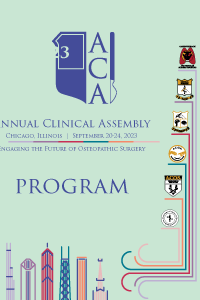General Surgery
Chest Radiographs Should Only be Obtained for Symptomatic Pediatric Patients after Fluoroscopic-guided Central Venous Catheter Placement
Location: Grandball Room 1-2
- DM
David R. Mann, DO, MS
Medical University of South Carolina
Charleston, South Carolina, United States
Primary Presenter(s)
Introduction/Purpose: Post-operative chest radiographs (CXR) after central venous catheter (CVC) placement have been routinely used to confirm positioning and evaluate for
complications in the pediatric population. Recent observational studies have questioned the practice of routinely obtaining these studies, especially for those who underwent placement with fluoroscopy. We sought to evaluate our experience with central venous catheter placement in children to determine (1) the rate of complications detected by post-operative CXR after CVC placement, (2) whether intervention was required for any complication, and (3) the radiation exposure and economic cost of post-operative CXR at our institution.
Methods or Case Description: After obtaining institutional review board approval, charts of pediatric patients undergoing central venous catheter placement by pediatric surgeons at our institution from January 2011 to December 2020 were reviewed. Patients with CVCs placed in femoral vessels, peripherally inserted central catheters (PICC), or those who underwent thoracoscopic surgery the same day were excluded.
Outcomes: 1,064 patients underwent central venous catheter placement during the study period. Eighty-five percent (n=938) received a post-procedure CXR. Of those who received a post-operative chest x-ray after fluoroscopic guided placement, 0.8% (n=8) had a post-procedure complication detected by CXR. Of the 8 complications, there were five pneumothoraxes, one pneumomediastinum, one hemothorax, and one catheter malposition. Of the 8 complications, two patients developed symptomatic pneumothoraces, of which only one required intervention with chest tube placement. The hemothorax required no intervention.
Conclusion: Post-operative chest radiographs offer minimal clinical benefit in asymptomatic patients after central venous catheter placement.
complications in the pediatric population. Recent observational studies have questioned the practice of routinely obtaining these studies, especially for those who underwent placement with fluoroscopy. We sought to evaluate our experience with central venous catheter placement in children to determine (1) the rate of complications detected by post-operative CXR after CVC placement, (2) whether intervention was required for any complication, and (3) the radiation exposure and economic cost of post-operative CXR at our institution.
Methods or Case Description: After obtaining institutional review board approval, charts of pediatric patients undergoing central venous catheter placement by pediatric surgeons at our institution from January 2011 to December 2020 were reviewed. Patients with CVCs placed in femoral vessels, peripherally inserted central catheters (PICC), or those who underwent thoracoscopic surgery the same day were excluded.
Outcomes: 1,064 patients underwent central venous catheter placement during the study period. Eighty-five percent (n=938) received a post-procedure CXR. Of those who received a post-operative chest x-ray after fluoroscopic guided placement, 0.8% (n=8) had a post-procedure complication detected by CXR. Of the 8 complications, there were five pneumothoraxes, one pneumomediastinum, one hemothorax, and one catheter malposition. Of the 8 complications, two patients developed symptomatic pneumothoraces, of which only one required intervention with chest tube placement. The hemothorax required no intervention.
Conclusion: Post-operative chest radiographs offer minimal clinical benefit in asymptomatic patients after central venous catheter placement.

